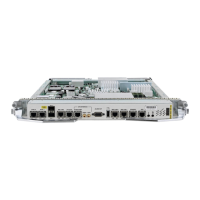The range for maximum paths is from 1 to 8 and the default number of maximum paths is 8.
Multi-Area Adjacency for OSPF Version 2
The multi-area adjacency feature for OSPFv2 allows a link to be configured on the primary interface in more
than one area so that the link could be considered as an intra-area link in those areas and configured as a
preference over more expensive paths.
This feature establishes a point-to-point unnumbered link in an OSPF area. A point-to-point link provides a
topological path for that area, and the primary adjacency uses the link to advertise the link consistent with
draft-ietf-ospf-multi-area-adj-06.
The following are multi-area interface attributes and limitations:
•
Exists as a logical construct over an existing primary interface for OSPF; however, the neighbor state
on the primary interface is independent of the multi-area interface.
•
Establishes a neighbor relationship with the corresponding multi-area interface on the neighboring router.
A mixture of multi-area and primary interfaces is not supported.
•
Advertises an unnumbered point-to-point link in the router link state advertisement (LSA) for the
corresponding area when the neighbor state is full.
•
Created as a point-to-point network type. You can configure multi-area adjacency on any interface where
only two OSF speakers are attached. In the case of native broadcast networks, the interface must be
configured as an OPSF point-to-point type using the network point-to-point command to enable the
interface for a multi-area adjacency.
•
Inherits the Bidirectional Forwarding Detection (BFD) characteristics from its primary interface. BFD
is not configurable under a multi-area interface; however, it is configurable under the primary interface.
The multi-area interface inherits the interface characteristics from its primary interface, but some interface
characteristics can be configured under the multi-area interface configuration mode as shown below:
RP/0/RSP0/CPU0:router(config-ospf-ar)# multi-area-interface GigabitEthernet 0/1/0/3
RP/0/RSP0/CPU0:router(config-ospf-ar-mif)# ?
authentication Enable authentication
authentication-key Authentication password (key)
cost Interface cost
cost-fallback Cost when cumulative bandwidth goes below the theshold
database-filter Filter OSPF LSA during synchronization and flooding
dead-interval Interval after which a neighbor is declared dead
distribute-list Filter networks in routing updates
hello-interval Time between HELLO packets
message-digest-key Message digest authentication password (key)
mtu-ignore Enable/Disable ignoring of MTU in DBD packets
packet-size Customize size of OSPF packets upto MTU
retransmit-interval Time between retransmitting lost link state advertisements
transmit-delay Estimated time needed to send link-state update packet
RP/0/RSP0/CPU0:router(config-ospf-ar-mif)#
Label Distribution Protocol IGP Auto-configuration for OSPF
Label Distribution Protocol (LDP) Interior Gateway Protocol (IGP) auto-configuration simplifies the procedure
to enable LDP on a set of interfaces used by an IGP instance, such as OSPF. LDP IGP auto-configuration can
Cisco ASR 9000 Series Aggregation Services Router Routing Configuration Guide, Release 5.3.x
431
Implementing OSPF
Multi-Area Adjacency for OSPF Version 2

